In my last blog I said that I love watching things grow in summer and the reason I love gardening is because with just a little water, some sunshine and good soil, voile! You have bountiful produce in no time! Well, nothing can be further from that this year. I had birds pecking on my seedlings, whiteflies and ants infesting my young vines, more birds pecking on fruit buds and whoa, humans pilfering the fruits, too! By and large, a very interesting and challenging growing season! 🙂
I planted my bitter gourd seeds around middle of May when it got fairly warm and by end of that month I had some sprouts.
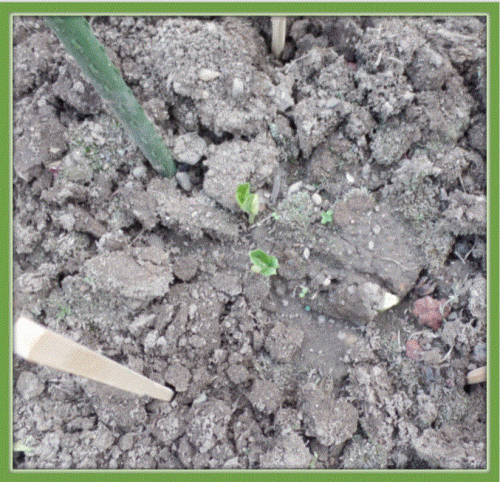
May 25, 2018
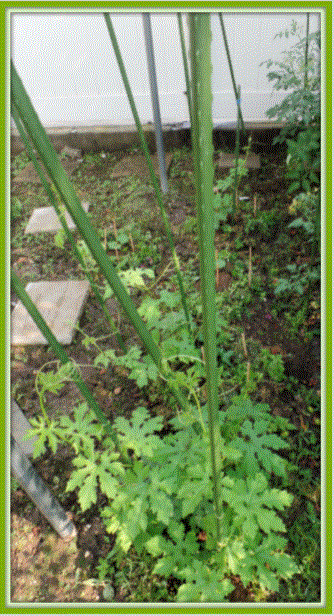
Jul 3, 2018
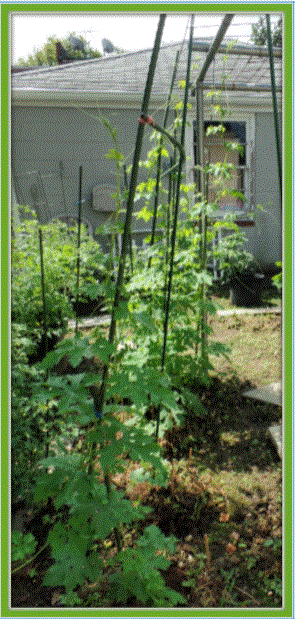
Jul 12, 2018
By the middle of July they had already reached the top of our trellis. They grew lots of leaves and branches too, so thick at the bottom that I was alerted to check on them when a friend told me she had powdery mildew on her grape vines. I looked up the remedy and cause of powdery mildew online and it says it is mainly dew to overcrowding. It occurs when the growth becomes too profuse and the best mitigation measure is to thin out the growth. I thought I better check on my bitter gourds, too. True enough, I was too late! They were already badly infested with whiteflies! How did I know they were whiteflies? No, I didn’t. I looked up pictures of common garden pests online and that’s how I identified the unwelcome guests in my plants!
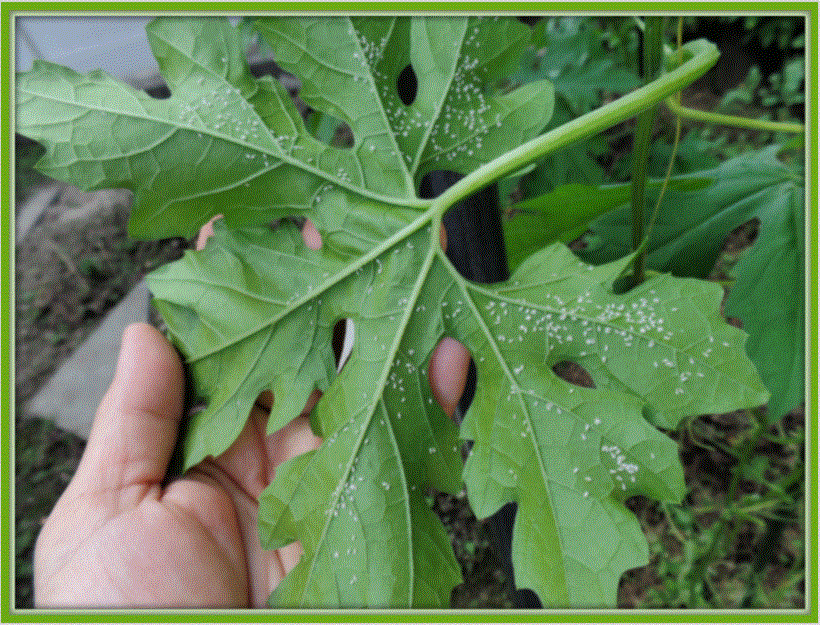
Jul 14, 2018 – Whiteflies Infestation
The attack was quite bad. I could not take a good pic of the most badly affected leaves because I did not want to disturb the whiteflies in them. I quickly cut off those leaves and isolated them in a plastic bag. I did that to prevent them from moving to the other plants in the garden and come back to infest my bitter gourd vines again once they recover from the gutting.

Jul 14, 2018 – Gutted Vines
Yes, in a drastic move to save the vines I applied the “scorched earth method” – I totally trimmed off the leaves and left only the buds at the top. See pic above. This removed most of the whiteflies and whatever larvae / eggs left behind would have limited greens to feed on. I also watched a vid on YouTube where some gardeners used water to hose down the whiteflies from hibiscus plants. I did that too, but soon regretted it because it turned out bitter gourd buds are too fragile for that treatment. The water jet blew away almost all the tender buds!
I was trying to keep to the natural ways of averting the pest attack so I looked online for the best plant repellent for whiteflies. French marigold, alliums (green onions and garlic) were among those I found. I used French marigold and green onions because they were the most readily available. I planted them immediately and ten days later they were quite established and healthy. Meanwhile, I kept manually brushing off new growths of whiteflies off the leaves. I also found out online that you can make a solution of chili pepper and garlic and spray it on the vines as the smell of those spices also repel whiteflies and other insects. So, I did that, too. I also did more mulching. I discovered that tansy is a kind of flower that strongly repels whiteflies because of its strong pungent smell. I realized that the weeds I had used for mulching two years ago kind of looked like tansy. Maybe it was its wild relative. So, I looked up those weeds again and used them for mulching, as well as dried leaves and whatever plant material I could get hold of. I believe these measures did help keep the infestation at bay because the whitefly population decreased severely after that.
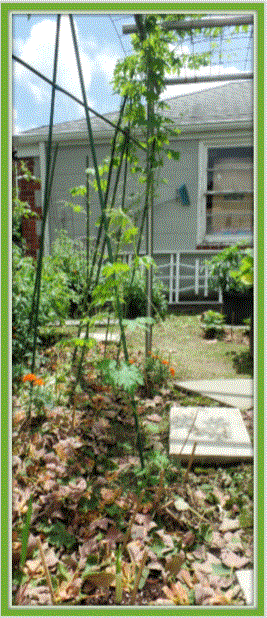
Jul 24, 2018 The tops bounce back.
After ten days the tops had grown to a healthy mass of foliage. There were already some fruit buds on the vines when the infestation occurred so, fruiting for this year was delayed by one week.
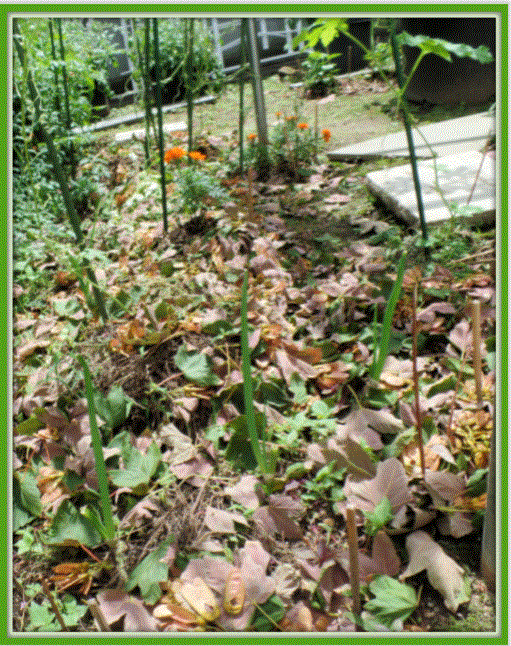
Jul 24, 2018 The insect repellent plants French marigold and green onions were established by now.
Soon after that I noticed something else. Tiny reddish-golden ants had grown in number and were over-running the vines, feeding on the succulent buds. According to my readings online, ants work in synergy with whiteflies because they feed on the wastes of the whiteflies. Hence, it was only logical that ants would become my next problem.
I looked online again for the natural remedies against ant infestation. I found this site where I got tips on how to get rid of garden ants using whatever you have at home – detergent, vegetable oil, water, white vinegar, etc. So, I followed their advice: Mix one teaspoon of dishwashing liquid soap and one and a half teaspoons of olive oil with some water. Now that was kind of tricky because I had to guess how much “some” water meant. I used only one cup of water and it probably turned out too concentrated. I also poured white vinegar on the ground where the ant nests were. Another method mentioned in the same article is by introducing nematodes into the soil. The nematodes invade the ant nests and prey on them. The only nematodes I know are those that naturally occur with mung beans. So, I thought I would plant mung beans in my garden (as I did two years ago) but I didn’t have any in my pantry at that time so I grabbed any beans I could find. I planted small red beans instead and they actually grew!
The young bitter gourd leaves sprayed on got “burned”! The burnt effect didn’t appear quickly but after the buds turned into fully-formed leaves the brown spots appeared and those leaves withered. The ones that were not sprayed on were good.
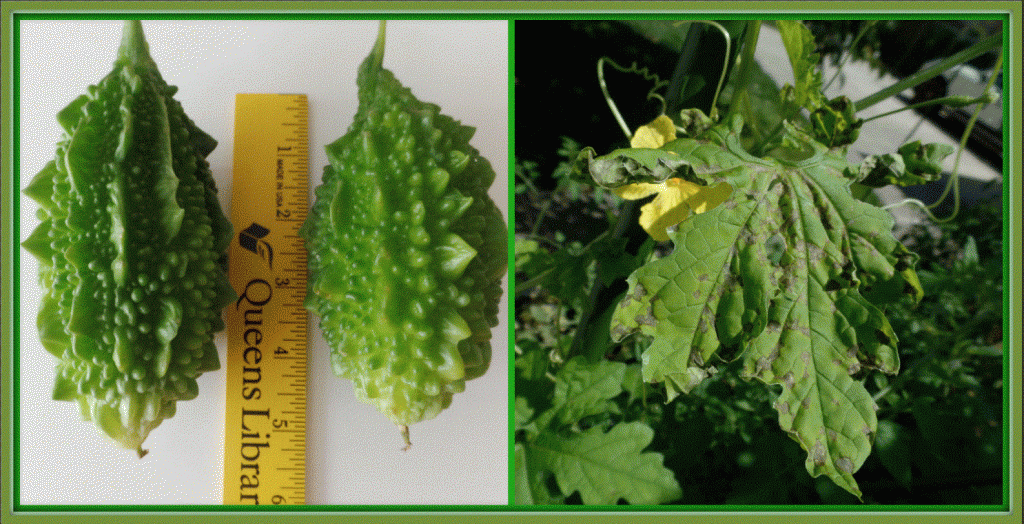
The first fruits were small, averaging 5 inches in length and the young leaves were affected by the home-made ant spray.
I had to trim off the withered leaves but the vines grew healthy. The ants reduced a lot towards the end of the planting season, too. The vines flourished and the fruits that followed were bigger and did not look blighted.
Eventually, the vines filled up the trellis and bore more fruits than I had two years ago. More in number but smaller in size. The majority averaged only about 6 inches long and 2-2.5 inches wide. The ones I had two years ago were averaging at 8 inches long and 3 inches wide. Now I wonder whether it’s because the vines this year were infested, affecting the size, or it’s because I planted more vines this time (5 vines instead of 2). I also wonder whether it’s because I harvested my fruits earlier this year because if I didn’t collect them early enough they got pilfered! I had no chance to wait for them to grow bigger.
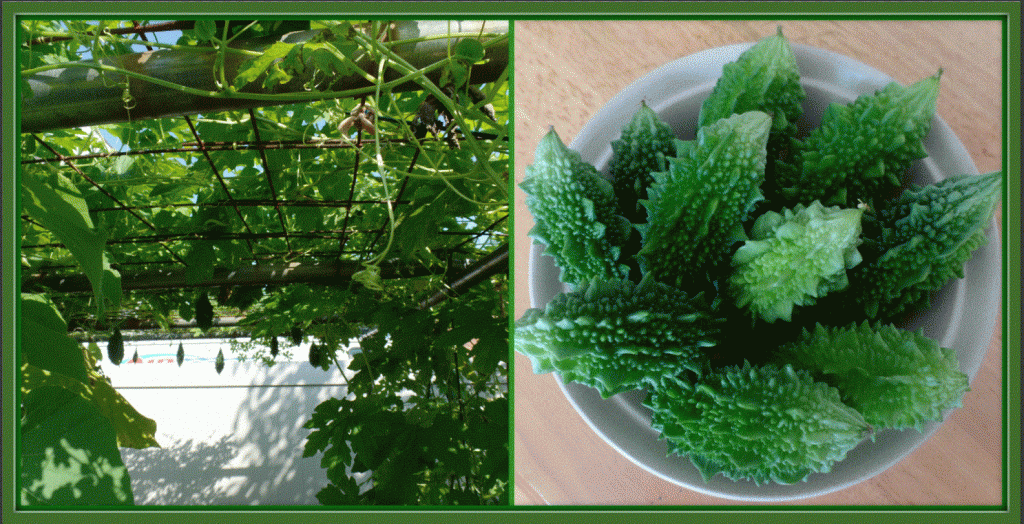
Mature vines and fruits.
At the beginning of the planting season I was lazy to do a lot of mulching and instead I thought I would just use organic fertilizer to enrich the soil.
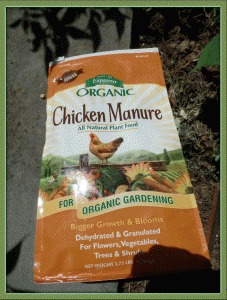
The organic manure I used as fertilizer.
This turned out to be a bad idea as it made the plants grow lots of leaves and branches at the bottom and created over-crowding which set the stage for whiteflies infestation. Apparently, mulching is the best way to go as it fertilizes the soil gradually and keeps the moisture in efficiently, causing slow but steady and healthy growth. Of course, it probably would have helped if I did not plant too many vines. I had to cut down four vines after I discovered the infestation, leaving only five.
Obviously, I didn’t know anything about over-crowding plants before this. I thought the more plants I have, the more fruits I would get.
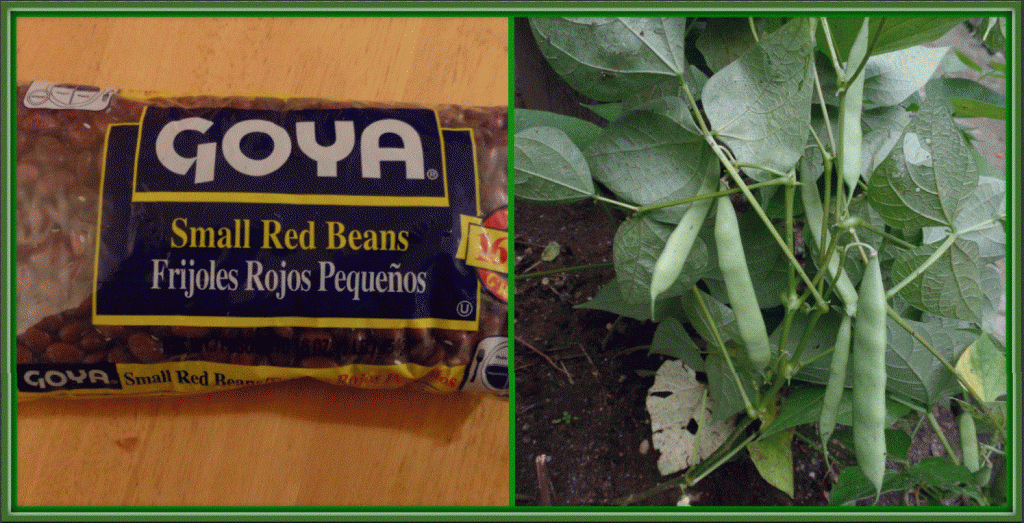
The small red beans I planted to boost the nematode population in my garden soil.
With the whiteflies and ant infestations I had this year I realized my success at growing bitter gourds two years ago (without any problems with pests) was because I did many things right, just by chance. I grew celery and green onions as early as spring. This year I found out that alliums (green onions is an allium) and cilantro are insect pest repellents. Celery is not exactly cilantro but they are kind of related. It is the essence of these plants that repel the insects. Two years ago I planted mung beans just for fun to see if it would grow and knowing that they grow fast, they could increase the nitrogen content of my garden soil and I could use some of the plants as mulch when I thin them out. This year I found out that another benefit of beans, besides enhancing soil fertility, is ant control. I may not know whether the particular nematodes that grow with small red beans are really the type that inhibit ant population growth but i would surely plant beans again as a companion crop when I plant my vegetables. Two years ago I continually mulched my bitter gourd plants with leaves, weeds, dry leaves, etc., whatever plant materials I could find. I did not use any fertilizer, organic nor inorganic. I totally depended on the mulch to fertilize the soil. That made my bitter gourd vines grow steadily, no growth spurts, no sudden overcrowding of leaves and branches. I also found out that the underlying concept in permaculture homesteading is mulching. It is a sustainable way to feed people organically although not many may have the means to own enough land to do that. Two years ago I grew only two vines, because those were all that germinated from the many seeds I planted. That itself prevented overcrowding. This year, after I responded to the challenges of the infestations of my bitter gourds, towards the end of the planting season I noticed I had a good mix of organisms in my garden, including ladybugs which I had taken for granted two years ago.
In summary, these are the hard lessons I learned about vegetable gardening this year:
- Don’t be lazy. Grow the spring season vegetables in spring (celery and green onions). They set a clean and safe environment for your summer vegetables. They will slow down in growth in the hot summer season but they would have fended away the harmful insects from the summer vegetables by then. Keep them growing as they will survive when the cool fall season sets in and you can keep harvesting them till the first snowfall.
- Don’t be lazy. Don’t resort to organic fertilizers from the market. They can cause growth overdrive and cause overcrowding which will attract pests. Do continuous mulching instead.
- Don’t do shortcuts. Grow seedlings in spring and replant them into your garden in summer. That’s how you fend off birds pecking on your seedlings.
- Don’t let your plants leave ground without their companion crops. Farmers don’t plant flowers with their crops for beauty. They are there to fend away pests! French marigolds are attractive, pungent and go well with bitter gourd vines. God meant plants to thrive symbiotically. Beans help fertilize your soil and also, apparently, fends off ants.
- Prevent overcrowding by planting plants about three feet away from each other. Don’t be simplistic and greedy thinking you can get more yields by planting more. It’s counterproductive.
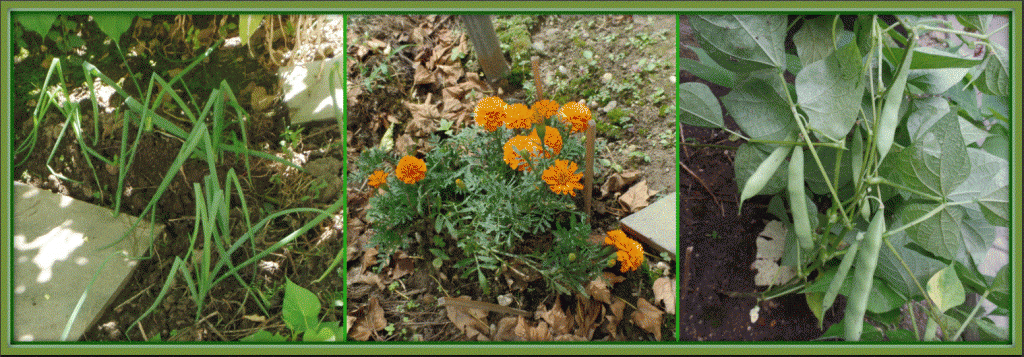
Companion plants (green onions, French marigolds and small red beans) – don’t let your garden plants leave ground without them.
So, did I have a happy summer? Oh yes, I did! Watching my plants grow and learning a few more gardening tricks make life more interesting than ever! Happiness is having plants! Let me know how your own planting season went in your comments below. Meanwhile, Happy Thanksgiving to those of us in America! Hope to see you all again in my next blog!
_________________________________________________________
References:
(1) P. Allen Smith Garden Home Staff. (2014, Oct 26).17 Plants to Control Pests [Article]. Retrieved from https://pallensmith.com/2014/10/26/17-plants-control-pests/ Access Date Jul 14, 2018.
(2) Oder, Tom. (2014, Oct 2). 12 plants that repel unwanted insects [Article]. Retrieved from https://www.mnn.com/your-home/organic-farming-gardening/stories/12-plants-that-repel-unwanted-insects Access Date Jul 14, 2018.
(3) Bogdanowicz, Richard. (2017, Feb 6). Repel Pests with Plants [Blog Post] Retrieved from https://permaculturenews.org/2017/02/06/repel-pests-plants/ Access Date Jul 14, 2018.
(4) Lohmiller, Becky and George. (Undated). Companion Planting Guide [Blog Post]. Retrieved from https://www.almanac.com/content/companion-planting-guide Access Date Jul 14, 2018.
(5) Fantastic Gardeners Team. (2017, Mar 7). Ant Killer tactics – How to Get Rid of Ants in the Garden [Blog Post]. Retrieved from https://blog.fantasticgardeners.co.uk/ant-killer-tactics/ Access Date Aug 6, 2018.
(6) Cuervo, M. and Medina, C., et al. (Undated). Nematodes – common bean [Article]. Retrieved from https://cropgenebank.sgrp.cgiar.org/index.php/management-mainmenu-434/stogs-mainmenu-238/common-bean/guidelines/nematodes Access Date Aug 7, 2018.
_________________________________________________________
If you wish to cite this blog, citation is as follows: PureJoyLand. (2018, Nov 20). [Blog Post]. Retrieved from http://purejoyland.com/2015/11/gardening-lessons-this-year/
————————————————————————————————
